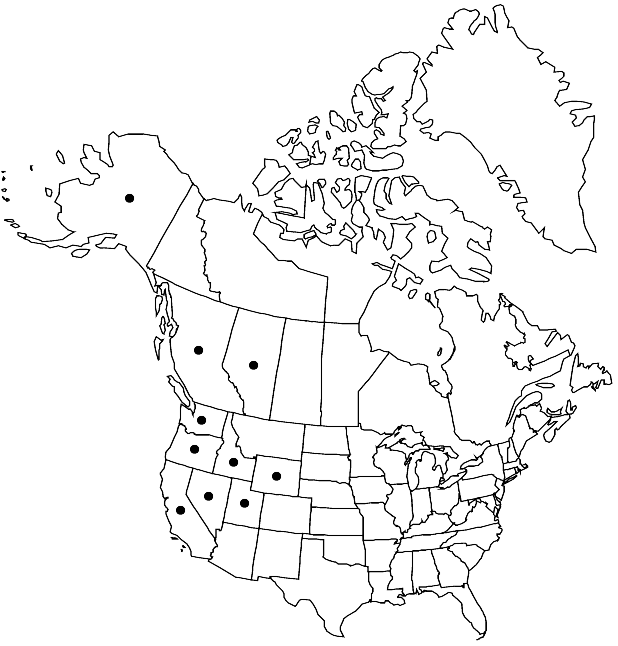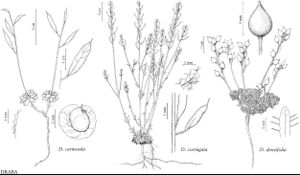Draba densifolia
in J. Torrey and A. Gray, Fl. N. Amer. 1: 104. 1838.
Perennials; (cespitose, pulvinate); caudex branched (dense with persistent leaf remains, branches sometimes terminating in sterile rosettes); scapose. Stems unbranched, (0.05–)0.2–1(–1.7) dm, usually glabrous, rarely pubescent, trichomes usually simple, 0.3–0.8 mm, and 2–4 (or 5)-rayed, 0.1–0.6 mm, (rarely predominantly simple ones). Basal leaves rosulate; sessile; blade linear to oblong or oblanceolate-linear, 0.3–0.9(–1.4) cm × 0.5–1.5(–2) mm, margins entire, (ciliate, trichomes simple, 0.3–1.2 mm), surfaces glabrous or sparsely pubescent, abaxially with short-stalked, 2–4-rayed trichomes, 0.1–0.3 mm (midvein prominent), adaxially rarely with subapical, simple trichomes. Cauline leaves 0. Racemes 2–10(–22)-flowered, ebracteate, not or slightly elongated in fruit; rachis not or slightly flexuous, glabrous or pubescent as stem. Fruiting pedicels divaricate-ascending to ascending (not decurrent basally), straight, (0.7–)1.5–10(–25) mm, usually glabrous, rarely sparsely pubescent, trichomes predominantly simple (0.2–0.7 mm), sometimes 2–4 (or 5)-rayed, (0.1–0.5 mm). Flowers: sepals ovate, 2–3 mm, usually sparsely pubescent, rarely glabrous, (trichomes simple and short-stalked, 2–4-rayed); petals pale yellow (sometimes fading white), oblanceolate to obovate, 2–5 × 1–1.7(–2) mm; anthers ovate or oblong, 0.4–0.6 mm. Fruits ovoid or ovate-lanceolate, plane (not curved), flattened, (2.5–)3–6(–8) × 2–3 mm; valves pubescent or puberulent, trichomes simple and short-stalked, 2–5-rayed, 0.1–0.4 mm; ovules 4–12 per ovary; style 0.3–0.6(–1) mm. Seeds oblong to ovoid, 1.2–2(–2.6) × 0.9–1.2(–1.4) mm. 2n = 36.
Phenology: Flowering Jun–Aug.
Habitat: Rock outcrops and talus, rocky knolls, alpine ridges
Elevation: 800-3700 m
Distribution

Alta., B.C., Alaska, Calif., Idaho, Nev., Oreg., Utah, Wash., Wyo.
Discussion
Draba densifolia is one of the most highly variable North American members of the genus, as evidenced by the extensive synonymy. The species is an apomict (G. A. Mulligan 1976) and it occupies tremendous geographic, edaphic, and altitudinal ranges. In forms corresponding to the type of D. sphaerula, the flowering stems are 2-flowered, and the stems, leaves, and fruiting pedicels are to 5, 1.5, and 0.6 mm, respectively. By contrast, forms comparable to the type of D. caeruleomontana var. piperi have stems, leaves, and fruiting pedicels to 17, 1.3, and 2.5 cm, respectively. Between these remarkable extremes fall all of the other populations of the species.
Draba densifolia is sometimes confused with D. paysonii, which it resembles, in being a cespitose, scapose, and densely pulvinate perennial having narrowly linear or oblong to linear-oblanceolate leaf blades with strongly ciliate margins. It is easily distinguished from the latter by having glabrous adaxial leaf blade surfaces, only sparsely pubescent abaxial surfaces, and often glabrous fruiting pedicels and rachises.
Selected References
None.
